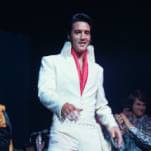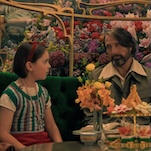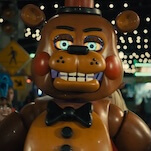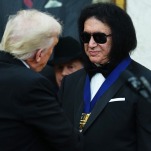10 episodes that show just how potent the CSI formula can be
The forensics detective show CSI: Crime Scene Investigation was something of a critics’ darling when it premiered in the fall of 2000. Writers such as James Wolcott and Joyce Millman praised it—in Millman’s words, it was a “crisp, technowhizzy whodunit.”
Slightly more than a month after giving the show honorable mention status in her yearly top ten list, Millman was having second thoughts. CSI, she wrote, “means to be hip and edgy, but doesn’t quite have the moves to pull it off. (Still, compared to most of what passes for drama on CBS, CSI looks like The Sopranos.)”
The passing reference to The Sopranos says a lot. Midway into its first season, CSI was already on its way to becoming a ratings juggernaut that would make it a rival to the reigning king of formula crime series and spin-off franchises, Law & Order. At a time when TV finally appeared to be growing up, what Millman calls “the show’s modest pleasures” gave it an old-school charm so long as it knew its place. But those same qualities could make it seem ominously counter-revolutionary once the show became a huge hit, claiming attention and eyeballs that would have been better lavished on edgier, more deserving shows.
In the 13 years since, CSI has kept plugging along. It’s produced more than 300 episodes, two spin-off series (not counting the forthcoming CSI: Cyber, starring Patricia Arquette), comic books, novels, and video games. It’s weathered cast changes, turning over the position of male lead twice—not counting a four-episode story arc during the seventh season when Liev Schreiber filled in for the show’s original star, William Petersen, while Petersen was acting in a play. It’s even inspired a term used by legal professionals: The “CSI effect” describes the discouraging phenomenon of juries expecting to see an impossible amount of meticulously assembled, incontrovertible forensic evidence in court cases, and deadlocking or automatically voting to acquit when they don’t get it. And somehow, we still managed to get The Wire, Battlestar Galactica, and Rick And Morty. Now that we know for certain that adventurous TV can peacefully coexist with the homey pleasures of CSI, maybe it’s time to revisit the show and try to determine why those modest pleasures once felt fresh, and why they’ve proven so durable.
For a start, by making heroes of scientists who solved crimes using their brains and lab equipment, the show made a refreshing change from all those post-Dirty Harry tough guys who relied on their guts to tell them who to shoot next. When it premiered, the show’s nerdy, brainiac crime busters and high-tech hardware suggested The X-Files without the alien abductions. (The show’s trademark Fantastic Voyage depictions of fatal injuries, seen from inside the body, were probably inspired by a scene in David O. Russell’s Three Kings.) Now, Gil Grissom (William Petersen), TV’s first entomologist detective hero, looks like the harbinger of a trend, the first of many attempts to re-conceive Sherlock Holmes (House, Sherlock, Elementary) for the age of geek chic. In Petersen’s hands, Grissom’s advice to his more hotheaded charges that they always “follow the evidence” because the evidence “cannot lie,” takes on the weight of Jean-Luc Picard’s good-nerd mantra: “Make it so.”
Petersen came to the role at the right time. In movies, Petersen started at the top, playing the pathologically revenge-fixated secret serviceman antihero of William Friedkin’s To Live And Die In L.A. (1985) and perhaps the best known of all forensicdetective heroes, the spooky FBI profiler Will Graham in Michael Mann’s Manhunter (1985). Those movies failed to make Petersen a star, and for good reason: He came across as cold blooded and unnervingly intense, without any leavening of charm or humor. Very quickly, he was downgraded to starring in TV movies and miniseries and appearing in such supporting roles as the bad husband in Cousins (1989) who drives his wife, Isabella Rossellini, into the arms of current CSI star Ted Danson.
By the time he signed on to play Grissom, he was 47 and had begun to trade in the lean, mean, and hungry look of his early roles for a fleshier, graying papa-bear quality that suited him and made him more likable then he’d been before.
Grissom was one of the good guys, but he still had an eerie, faintly creepy edge to his eccentricity that saved him from blandness. Grissom was the night shift supervisor of CSI, and while that gave his team first pick of the most garish cases and the most shadowy, film noir crime scenes, nobody gets stuck being the night shift supervisor of anything without looking like a loser, or at least a weirdo. Grissom proved his bravery not by putting himself in physical danger but by refusing to play politics when it got in the way of doing his job. So he was left in the dust by his charmless rival, Ecklie (Marc Vann), who knew how to play the game. Grissom seemed to like being left behind to concentrate on his corpses and bugs, but the show kept viewers guessing: Was his single-minded devotion to his scientific work the result of moral integrity, or is he a person with Asperger’s? The one thing that was clear was that Grissom, who was fond of saying that he and his team “speak for the dead,” was the guy you’d want speaking for you if someone cut short your time on this Earth.
Petersen left the show partway through the ninth season, eager to return to the stage and get away from all those bugs and corpses. He was replaced by Laurence Fishburne, an actor capable of great performing with great power and slyness, who is also capable of stiffening up and inflating himself with so much stentorian pomposity that he suggests an Animatronic escapee from Disney World’s Hall Of Presidents. He stayed locked in humorless gasbag mode for most of his three seasons at the helm. The show went a ways toward remaking itself in the 12th season, when Ted Danson, fresh from his own career-making role as a pothead magazine editor on Bored To Death, took over as Supervisor D.B. Russell. The contrast between the stern heavyweight thespian Fishburne and the nimble, cheerfully oddball Danson could give viewers whiplash. Since the show debuted, other regular cast members have left (Marg Helgenberger, Gary Dourdan), arrived (Elisabeth Shue, Wallace Langham), or both come and gone (Jorja Fox). But 14 seasons is a long time, and CSI’s cast roster is the Rock Of Gibraltar compared to that of Law & Order or any of its offshoots. Another difference between the two shows is that Law & Order—with its “torn from the headlines” cases and jaundiced view of the criminal justice system—could tell its viewers something about the real world. CSI, set in a world where cops clear a path for forensic scientists to gather data in a pristine setting and haul it back to their well-funded labs to produce the clear-cut results that solve cases definitively, is a fantasy. But to look at the show’s best episodes is to confirm that it is a beguiling fantasy, just as to look at any of its imitators (including its own “official” spin-offs) is to confirm that it’s not an easy one to pull off.








































